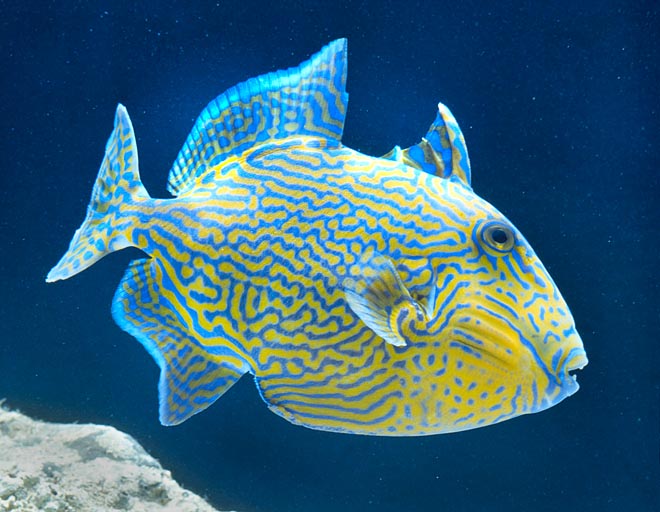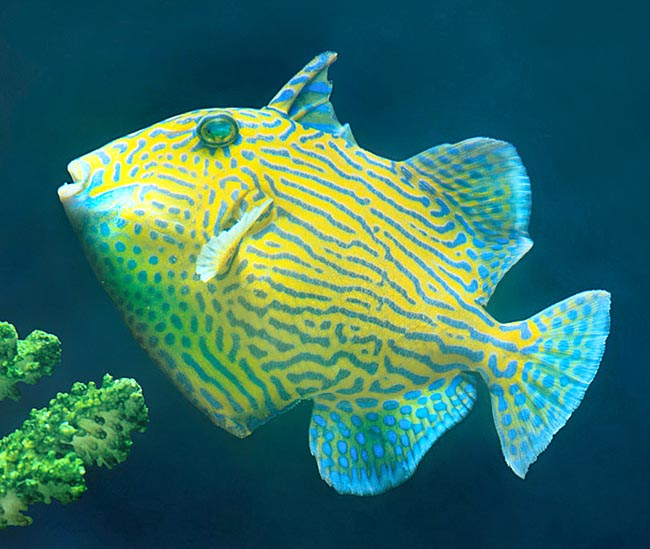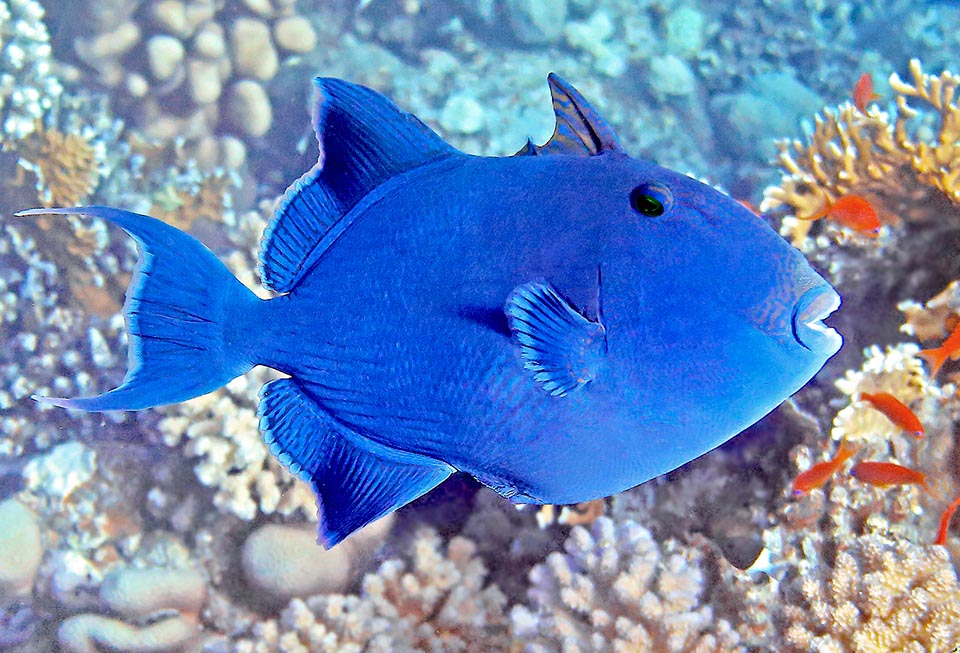Family : Balistidae

Text © Giuseppe Mazza

English translation by Mario Beltramini

Pseudobalistes fuscus lives in the Indo-Pacific and may be 55 cm long © Giuseppe Mazza
The showy Yellow-spotted triggerfish (Pseudobalistes fuscus Bloch & Schneider, 1801) belongs to the class of Actinopterygii, the ray-finned fishes, to the amazing order of the Tetraodontiformes and to the family of Balistidae, the trigger fishes.
The etymology of the genus “pseudobalistes” comes from the Greek “pseudes” = false, apparently similar, and from the Latin “ballista” = crossbow, the same etymology of the genus Balistes. It is therefore a fish very close to the genus Balistes.
The name of the species comes from the Latin “fuscus” = dark, with reference to the midnight blue livery on which stands out, at times, a yellow pattern.
In Italian it is also named blue triggerfish, but this often creates confusion with the Odonus niger, by sure smaller and with a much more slender shape.
Zoogeography
It is present in the tropical waters of the Indian and Pacific oceans, where however it is more rare. We find it, as an indication, along the African coast, from South Africa to the Red Sea, to the Seychelles, Mauritius, Réunion and Maldives, in India, Sri Lanka, Thailand, Australia, Indonesia, New Guinea, Micronesia, Philippines, Taiwan and China up to Japan. Eastwards, it has colonized Samoa and the Society Islands. Southwards, it reaches Tonga and New Caledonia.
Ecology-Habitat
It lives in the madreporic formations, usually between the 30-50 m of depth.

Changeable livery. In the young the yellow arabesque prevails, the contrary in adults © Giuseppe Mazza
Morpho-physiology
It can be 55 cm long. The body is flat, ovoid, protected, like all triggerfishes, by a solid coating of bony scales. The first dorsal fin is an erectile trigger formed by three spiny rays which the animal may block in vertical position for defence. Typical of the Balistidae, it keeps armed even when the animal is dead, and the first spine, long and sharp, often discourages the aggressors. It is furthermore useful for entering shelters with small entrance with the fin lowered down and then arms it and sleeps soundly, safe from large predators, and without being taken out by the currents.
The second dorsal fin counts 24-27 soft rays and is almost specular to the anal, somewhat shorter, which has 19-24 of them. The pectoral fins count 14-16 unarmed rays, the ventral ones are reduced to a protuberance and the caudal, rounded in the juveniles, becomes then truncated and finally crescent-shaped in the adults.
The robust mouth shows solid incisors used for breaking madrepores and shells.
In the livery of the juveniles the yellow arabesque on the blue background prevails, in the adults it’s the contrary.
Ethology-Reproductive Biology
The yellow-spotted triggerfish nourishes of sea urchins, crustaceans, molluscs, tubeworms, polyps of madrepores and carcasses of dead fishes.
As it is usual among the triggerfishes, it digs a nest in the sand with water jets from the mouth and after the spawning the female keeps the watch till the hatching of the eggs attacking the intruders with ferocity.

Beautiful old specimen. Due to its size, the Pseudobalistes fuscus is often fished and consumed fresh or dried by the local populations © Gianemilio Rusconi
The less than 5 cm long juveniles have black spots on the back and dark undulated lines more or less interrupted. Then appear some bright blue lines, so much unevenly that the fish, with an unbelievable detachment, may have a blue background in the upper mid and yellow in the lower one. Finally, the yellow with the blue veinings intensifies: this is the most beautiful livery, which fades with the time to become of an almost even dark blue.
Due to its size, the Pseudobalistes fuscus is often fished and consumed fresh or dried by the local populations. The members of the species may double in 1,4-4,4 years, but the vulnerability index is to be watched because we have already reached the 43 on a scale of 100.
Synonyms
Balistes caerulescens Rüppell, 1829; Balistes fuscus Bloch & Schneider, 1801; Balistes rivulatus Rüppell, 1837.
→ For general information about FISH please click here.
→ For general information about BONY FISH please click here
→ For general information about CARTILAGINOUS FISH please click here.
→ To appreciate the BIODIVERSITY of BONY FISH please click here.
→ To appreciate the BIODIVERSITY of CARTILAGINOUS FISH please click here.
